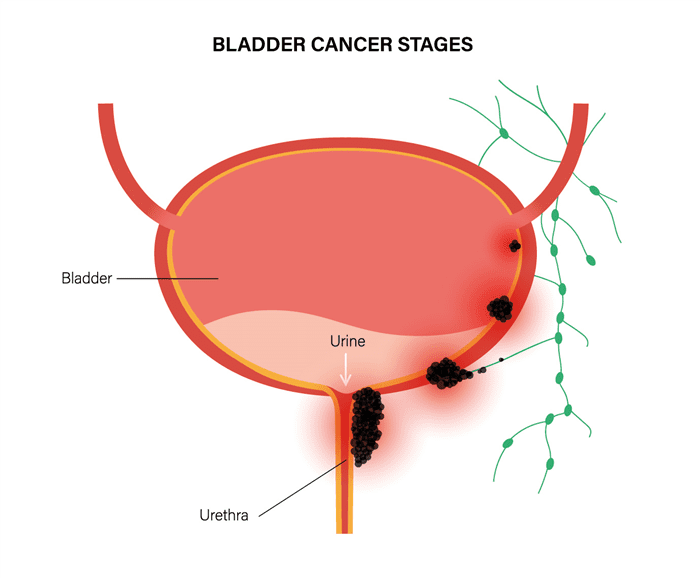After patients have been treated for superficial bladder cancer, they must have regular follow-up examinations in order to detect any recurrence that may occur.
Risk factors and warning signs for bladder cancer
Although the cause of bladder cancer is unknown, it is associated with tobacco use and exposure to certain chemicals.
Smoking and bladder cancer: according to the American Cancer Society, smoking is responsible for about 47 percent of bladder cancer deaths in men and 37 percent in women.
Occupational exposure and bladder cancer: workers in the rubber, chemical, leather, textile, metal, and printing industries who are exposed to substances such as aniline dyes and aromatic amines may be at increased risk for bladder cancer. Other high-risk occupations include hairdressers, machinists, painters and truck drivers.
Warning signs or. Symptoms of bladder cancer
The most common warning sign of bladder cancer is blood in the urine (hematuria), which may or may not be visible. (Visible blood in the urine is called macrohematuria, and non-visible blood in the urine is called microhematuria.). Other symptoms may include: altered bladder emptying habits, e.g. More frequent urination, urgent urination, or burning with urination; urinary urgency that cannot be satisfied; difficulty initiating or stopping urine flow; weak, interrupted, or painful urine flow; abdominal pain; loss of weight or appetite; persistent lower back, thigh, or pelvic pain.
Bladder cancer screening and diagnosis
If doctors suspect a patient has bladder cancer because they notice blood in the urine, urinary urgency, burning during urination, or an unexplained accumulation of urination, they may use several methods to confirm the diagnosis and determine the stage (spread) of the disease. We also use laboratory tests and other diagnostic techniques:
Urine cytology: in this test, doctors examine the urine under a microscope to look for abnormal cells. (This is similar to a pap smear.) You may also do a urine culture to rule out infection, which can cause symptoms similar to bladder cancer.
Cystoscopy : The urologist inserts a cystoscope, a flexible instrument used to view the bladder, through the urethra into the bladder and examines it for possible cancers. In the past, cystoscopy was performed with a rigid metal instrument that was associated with significant discomfort. The most modern instruments, like the ones we use, are small and flexible and have small camera chips on the end instead of lenses. This improves visualization and makes the examination much less stressful.
Biopsy : During a cystoscopy, the doctor removes suspicious tissue, which a pathologist examines under a microscope for signs of cancer. Small biopsies can be done in office hours, but deep biopsies require anesthesia, and patients stay in the hospital for one to two days after the biopsy.
CT Urography: The patient is injected with a contrast agent into the bloodstream, which is transported in the kidneys to the renal pelvis and from there via the ureters to the bladder, showing these organs or. More clearly depicts the hollow system on CT images. With this examination, it may be possible to determine where the blood in the urine is coming from. In addition, a computed tomography (CT) scan of the abdomen and pelvis can show how far a tumor may have spread outside the bladder.
Magnetic resonance imaging : An MRI scan of the abdomen and pelvis can also show whether the urinary tract is normal, and if cancer is present, how far it has spread outside the bladder. MRI is preferable to CT in some patients with impaired kidney function.
Ultrasound examination : This procedure uses sound waves to easily and quickly determine if there are any space-occupying lesions in the bladder.
Staging of bladder cancer
Staging bladder cancer, which indicates how far the cancer has spread, helps doctors choose the most effective therapy. Staging takes into account how deeply the tumor has penetrated the bladder wall and whether it has spread to lymph nodes and metastasized or spread to other organs.
Cancer has spread to more distant organs, such as bones, liver or lungs.

Screening for bladder cancer
Early-stage bladder cancer is usually asymptomatic or shows symptoms that may resemble those of a benign condition such as bladder stones, an enlarged prostate, or a urinary tract infection. For this reason, it is important to have regular checkups with a physician. If symptoms occur, they should be examined promptly so that bladder cancer can be detected in the earliest, most treatable stages.
During an examination, the physician may perform some screening tests. During a urine cytology test, the doctor examines the urine under a microscope to look for cancer cells or precancerous cells. In another exam called cystoscopy, urologists insert a cystocope, a flexible instrument, through the urethra into the bladder. They examine the bladder and the urethra for signs of cancer, remove suspicious tissue and examine it under a microscope.
Prevention of bladder cancer
If possible, bladder cancer patients should refrain from smoking – a significant risk factor for developing the disease – and limit their occupational exposure to certain dyes and chemicals used in rubber and leather processing, which have been shown to increase the risk of bladder cancer.